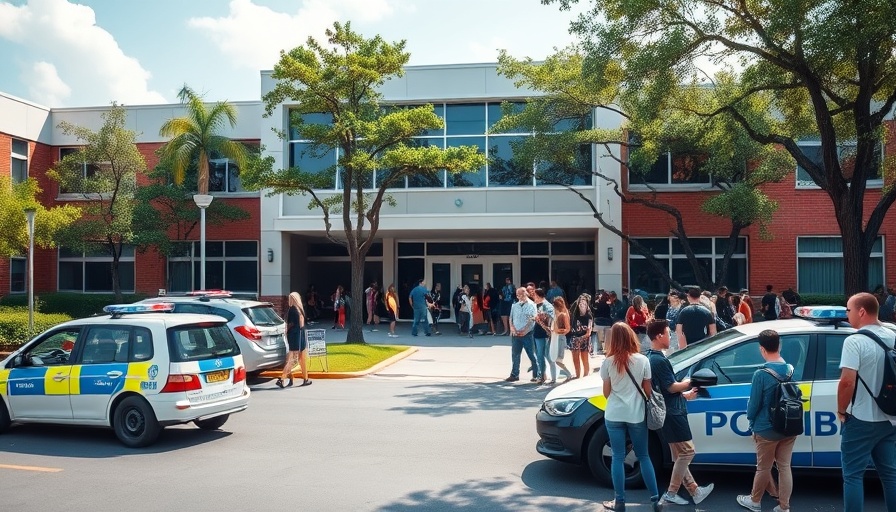
 Add Row
Add Row  Add Element
Add Element Empower Your Grant Writing: 10 Books Every Law Enforcement Professional Needs


How Law Enforcement Can Enhance School Safety and Protect Students
Update The Ongoing Crisis in School SafetyThreats to schools have become a worrisome reality across the United States, necessitating proactive measures from law enforcement agencies. The increase in school shootings and other forms of violence highlights the urgent need for comprehensive strategies aimed at protecting students. Police leaders and officers are actively engaged in addressing these threats through a combination of response planning, community outreach, and the assignment of dedicated School Resource Officers (SROs).Bridging the Gap Between Knowledge and ActionDespite the wealth of studies on the psychology of school shooters and the pathways that lead to violence, transforming academic insights into actionable strategies presents a major challenge. Police leaders are often caught in the dilemma of understanding threat management without a clear operational approach for implementation. Training sessions, meetings, and workshops need to be emphasized—not just as formal interactions but as vital channels for translating learned concepts into daily routines of law enforcement.Community Engagement: A Crucial ComponentCommunity engagement plays an indispensable role in safeguarding schools. By strengthening relationships between law enforcement agencies and the communities they serve, officers can foster a culture of trust and openness. This approach encourages more effective communication regarding potential threats. Regular community outreach initiatives can break down barriers, making it easier for students, parents, and educators to report concerning behaviors without fear.The Role of School Resource OfficersSchool Resource Officers (SROs) are critical in the landscape of school safety. Their presence in educational institutions can deter violence, provide immediate support to students experiencing crises, and serve as a bridge between the school environment and law enforcement. SROs should receive extensive training, not only in law enforcement techniques but also in conflict resolution and youth engagement—ensuring they are equipped to handle sensitive situations that require a nuanced approach.Future Trends: Evolving Strategies for SafetyAs threats evolve, so too must the strategies employed by law enforcement agencies. The future of school safety lies in utilizing advanced technologies, such as surveillance systems, threat assessment software, and data analytics, to ensure comprehensive monitoring of school environments. However, as these technologies are integrated, it’s crucial to remain vigilant about privacy concerns and maintain a balance between safety and civil liberties.Conclusion: A Call to ActionAs we grapple with the rising tide of school violence, it is essential for police leaders and policymakers to come together and develop well-rounded strategies that prioritize protective measures while fostering community trust. Engaging with local communities, systematically implementing safety protocols, and evaluating emerging technologies will be vital. Everyone has a role to play, and through collaborative efforts, we can create safer educational environments for our students.

Unlocking the LEMAS Survey Insights to Enhance U.S. Law Enforcement
Update A Comprehensive Overview of the LEMAS Survey The Law Enforcement Management and Administrative Statistics (LEMAS) Survey serves as the cornerstone for understanding the operational landscape of U.S. law enforcement agencies. Conducted periodically by the Bureau of Justice Statistics, this survey gathers vital data from police departments across the nation, painting a picture of trends in management practices, staffing, and technological advancements. Why the LEMAS Survey Matters for Law Enforcement For law enforcement professionals and government policymakers, the data from the LEMAS Survey is critical in informing policy decisions and resource allocation. As public safety issues evolve, understanding which agencies are employing early warning systems or specialized units enables stakeholders to identify best practices and areas requiring additional focus or funding. Insights Into Staffing and Resources One of the key components of the LEMAS Survey is its examination of staffing levels across various departments. The data allows for a comparative analysis of how agencies have adapted to changing community needs and crime trends. Insights into staffing can also reflect broader societal shifts, such as increases or decreases in crime rates, which have notable implications for community safety. Technological Integration and Advancements The survey also delves into the incorporation of technology within law enforcement. In an age where technology plays a vital role in policing strategies, knowing how many agencies have implemented body-worn cameras, mobile data terminals, and other tech aids provides a glimpse into how law enforcement is evolving. The findings from LEMAS can guide future investments in public safety infrastructures. Improving Community Engagement and Trust Increased transparency resulting from surveys like LEMAS enhances accountability in law enforcement agencies. Community trust hinges on police departments being responsive to their constituents' needs and fostering cooperative relationships. The data reveals how agencies are engaging with the communities they serve and the mutual impact of these interactions. Future Directions for Law Enforcement Data Collection The future of law enforcement data collection looks promising, yet it is not without challenges. With growing interest in police reform and community-based approaches to policing, the LEMAS Survey could evolve to include more qualitative measures, capturing the nuanced experiences of officers and community members alike. Policymakers will need to balance quantitative data with deeper insights to forge effective paths forward. The information collected in the LEMAS Survey not only informs policymakers but also empowers law enforcement leaders to make evidence-based decisions, shaping the future of public safety across diverse communities in America. Engaging with this data offers the opportunity to understand systemic issues and drive meaningful change within law enforcement agencies.

Understanding Liability: Essential for Competent Law Enforcement Investigations
Update The Importance of Competence in Investigations The foundation of trust between law enforcement and the communities they serve is built on competent investigations. This expectation extends beyond the protection of rights afforded by the Sixth Amendment; it holds police officers accountable for their actions during investigations. A closer examination reveals that failure to investigate crucial exculpatory information can have disastrous consequences, potentially leading to wrongful convictions and eroding public trust. Legal Obligations: Beyond the Sixth Amendment Just as defense attorneys are held to a standard of competency, police officers have similar, albeit less frequently articulated, obligations. Implementation of the law should inherently safeguard individuals from harm, implying that inadequate investigations can jeopardize public safety. Therefore, law enforcement agencies must ensure their officers are well-trained and equipped to perform their duties competently, emulating the expectations placed on the legal representatives who advocate for defendants. Recent Cases: Lessons Learned Reflecting on high-profile cases exposes systemic issues where incompetence can persist at various levels within the investigative process, such as detective work not prioritizing critical leads or overlooking exculpatory evidence. For instance, the infamous wrongful conviction case of Richard Phillips, whose conviction was eventually overturned after 45 years, underscores the need for meticulous investigations. A failure to pursue vital evidence resulted in a miscarriage of justice, amplifying calls for improved investigative climates. Future Trends: The Rise of Accountability in Law Enforcement As reform efforts gather momentum, the legal obligation for competent investigations is likely to become more pronounced. Officers will increasingly be held accountable for their investigative choices, and departments will need to adopt transparent practices. This can involve regular audits of cases and implementation of technology to track investigative efficiency. Emerging trends suggest shifts towards collaborative frameworks where public opinion plays a crucial role in shaping policy, thereby enhancing accountability. Actionable Insights for Law Enforcement Agencies Police departments must invest in training programs focusing on investigative techniques and the vital importance of due diligence when handling sensitive cases. Beyond continuous education, fostering a culture of accountability through internal probes will encourage officers to prioritize the quality of their work. Simple yet effective strategies such as community policing can also bridge gaps between officers and the public, thus revitalizing trust and collaboration.
 Add Row
Add Row 

Your trusted source for data-driven strategies and actionable insights in public safety. Bridging the gap between research and real-world application, offering in-depth analysis, and expert perspectives to enhance community trust and improve public safety outcomes.
 Add Element
Add Element  Add Element
Add Element  Add Element
Add Element © 2025 Local Click A.D.S. All Rights Reserved. 6 Myrtle Ave, Cambridge, NY 12816 . Contact Us . Terms of Service . Privacy Policy


Write A Comment